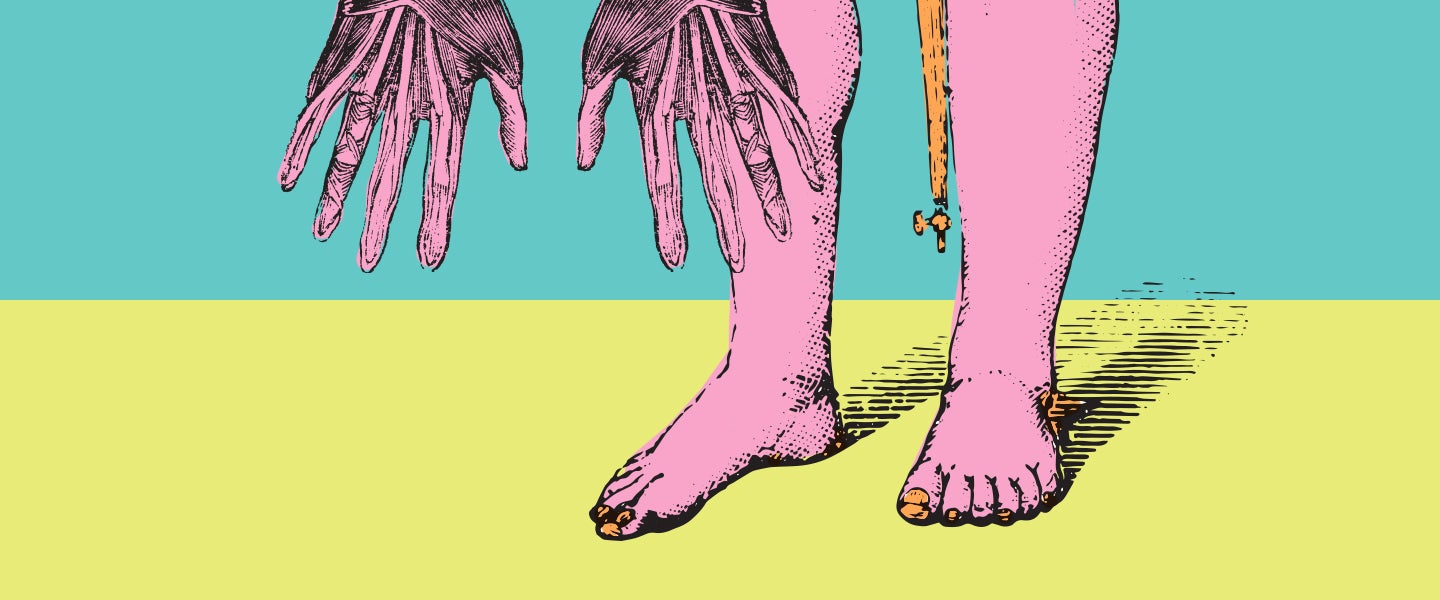Spider-Man can’t touch his toes.
Er, rather, Tom Holland, the guy who plays Spider-Man, can’t. According to a red carpet interview with Celebrity StarCast, he was asked to “get flexible” for his now-infamous role, but as he bashfully demonstrates for the camera, that didn’t work out so well. When he bends down, his fingers just barely graze the middle of his shins. He dangles there like a limp noodle for a moment to prove his point, then stands back up again, forlorn and inflexible as a tin man.
If you’ve ever been a man in a yoga class, one of the millions of kids who had to “sit and reach” for the now-defunct Presidential Fitness Test or one of the many male YouTubers who film themselves trying — and largely failing — to touch their toes, chances are you can relate. All across the country, men are struggling to touch their toes, and if their stories are to be believed, they have been struggling for some time. And while there’s no research that documents their struggles directly, there is an entire internet of men out there who, like Holland, cannot perform one of life’s most basic, and fitness-affirming stretches.
I've never been able to touch my toes. Ever.
— TUCKER (@JERICHO) February 1, 2019
The men of Reddit can confirm. In an r/AskMen post entitled “Can You Touch Your Toes?” the general consensus between commenters seems to be that toe-touching is but a pipe dream they were rudely awakened from, mostly on account of their supernaturally tight “hammies.” “I haven’t been able to do that for many, many years,” writes Kastoli in response to the titular question. “My hammies just aren’t stretchy enough, and after spending so many hours every day sitting, my waist doesn’t even bend to a 90-degree angle.” Ditto for Atlantis145: “I have hammies with the stretchiness of steel beams. I stretched every day for an entire summer and got zero results for the effort I put in.”
Sad!
Meanwhile, on YouTube, people like Seth Alexander are making poetic short films about the trials and tribulations of toe-touching, and dumb, backcountry Chads are chiding each other with derogatory slurs for not being able to do it.
Obviously, not all men are rigidly inflexible steel beams: This guy can rotate his torso 180 degrees whenever he wants, and this one can suck his own dick (link NSFW). But for the most part, research does tend to show that men aren’t all that flexible relative to women, particularly in the toe-touching department.
Why is that, though? Why do some men have such a uniquely hard time touching their toes relative to women?
Well, the short answer is that no one knows for sure. However, there are a couple theories. One, which was hotly debated on Reddit, is that higher estrogen levels in female bodies softens the collagen fibers that make up tendons and ligaments, making them more pliable so that the muscles they attach to can stretch further. Hypothetically speaking, less estrogen in male bodies would mean less elastic tendons and ligaments that don’t permit men’s muscles to extend quite as far. Another is that female musculature also tends to be longer and leaner, which, while less ideal for bulking up Arnold-style, makes flopping forward toward your toes like a Raggedy Ann doll with a fettuccine noodle for a spine a lot easier.
So it’s possible that men’s hamstrings and hip flexors — the muscle groups that allow you to bend forward toward your toes — are both shorter and less elastic than women’s, creating a perfect storm of inflexibility that might explain videos like this:
While the “hammie” and hip flexibility certainly matter when it comes to the toe-touch, some physiologists like Jeffrey Jenkins of the University of Virginia School of Medicine say a much bigger factor is the relative length of your arms and torso to your legs. If you’re Michael Phelps, whose arms are, according to my estimates, roughly 20,000 times longer than his torso and legs, it’s probably relatively easy to touch your toes. “On the other hand,” Jenkins told Popular Science, “someone can be really flexible, but if their arms and hands are short relative to their legs, then even at their maximum flexibility they might still not be able to touch their toes, because their arms and fingers aren’t long enough to reach.” The only thing that determines what that golden arms-torso-legs ratio is, of course, is genetics.
Phelps genes and physiology are only part of the story, though. As Deborah Bowes, a San Francisco-based Feldenkrais trainer (Feldenkrais is a type of exercise therapy) explained to boomer magazine Next Avenue, there may be some cultural behavioral factors at play as well. For one, the gendered way in which children are raised means some of them — usually the girls —are directed toward flexibility-enhancing activities like ballet. Meanwhile, others — usually the boys — are pushed toward activities like football or basketball that focus on strength. So, from an early age, many men never learn how to maximize their flexibility, and their bodies develop in a way that reflects this.
As adults, many men also stretch and work out far more intensely than they actually need to, likely in part because it either consciously or unconsciously confirms their sense of masculinity. Case in point: On the blog The Art of Manliness, there’s an article on the connection between masculinity and exercise by a mononymous guy named “Brett” who encourages his male readers to exercise in ways that “put you in pain.” Painful workouts, he writes, helps men “connect with those primal instincts” and push their bodies “to the limits.”
Nowhere is this workout ethos more apparent than in the military, where Bowes says a patient of hers was told to stretch his lower back and hamstrings by holding a 25-pound weight in each hand and bending forward while someone else pushed down on their backs “really hard and quick.” And while that’s a great way to show your military bros that you can take the pain for your country — and to “push your body to the limit” — Bowes says it’s also a great way to injure a hamstring, ligament, tendon or vertebral disc.
Because of that “harder not smarter” mentality, men are also more likely to injure themselves during workouts that might actually enhance their flexibility like dance, yoga and pilates. For that reason, many of them avoid these types of exercises altogether, regarding activities that lengthen — as opposed to strengthen — as a “female domain, foreign and discomfiting.” Truth be told, only 28 percent of yoga and 16 percent of pilates students are men (the number of men in dance is hard to estimate because it depends on the type of dance). That means many men may be missing out on exercises and workouts that might help them attain their full range of flexibility.
The question is, though, who cares? Touching your toes is often touted as some sort of vital symbol of overall health and fitness, but how much does it actually matter if you can’t? Does not being able to take your piggies to market somehow mean you’re throttling toward premature death at a rate much faster than those of us who can high-five the ground?
Hardly. While Jenkins explains that the toe-touch does promote blood flow and can help prevent certain kinds of injuries by making both muscles and the fascia that surrounds them more flexible, he’s not sold on the idea that it’s the crowning achievement of physical health. “In terms of specifically touching your toes, I’m dubious about its effect on fitness and health because there are so many factors beyond your control,” he says. In fact, he explains, improving flexibility in the lower limbs can actually decrease muscle strength and efficiency, particularly during exercises like running. However, at the same time, it can also improve posture, relieve stress, ease back pain and indicate whether or not you may have heart disease, so provided you don’t need super ripped legs and you just want to increase your flexibility and circulation a little, there’s no reason why you shouldn’t shoot for the stars (or least your toes) and try to get yourself there.
Interestingly, some fitness experts like personal trainer and MMA coach Jason Parsons recommend you don’t do this the old-fashioned, “forward fold” way. Instead, as he wrote in a blog post for Fit Men Cook, use a foam roller to open up your calves, hips and back or focus on strengthening (not stretching) your hamstrings with hip-extension exercises like kettlebell swings, various types of squats or even hop on the rower. Daniel Vadnal of FitnessFAQs also says learning how to tilt your pelvis posteriorly can help, something you can do with planks, a modified leg lift and some range of motion exercises (all of which you can see here).
Of course, if you’re dying to forward fold the classic way, there’s always yoga. According to a survey by sportswear brand Sweaty Betty, 87 percent of people who practice yoga regularly can touch their toes. A good rule of thumb, says Jenkins, is to hold any stretching pose for at least 60 seconds, breathing through it even if it hurts (though it should never be excruciating — that means you’re hurting yourself). So as long as you realize toe-touching doesn’t take place overnight and you’re willing to put in work nearly everyday to get there, you should theoretically be able to do it.
And if you still can’t, well, join the club.

